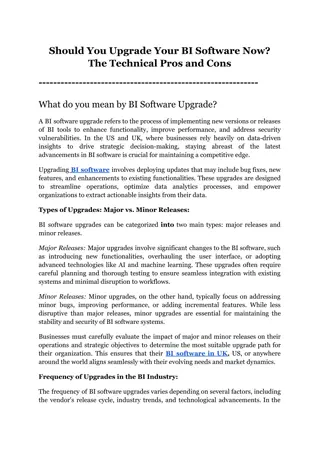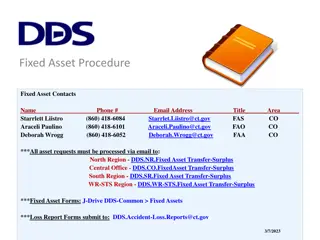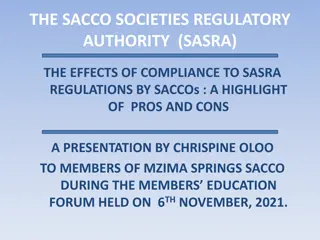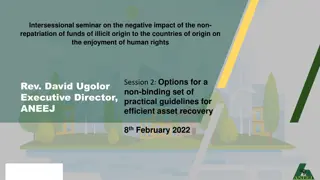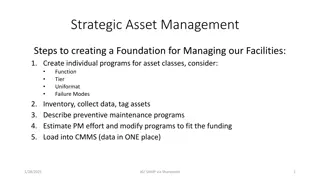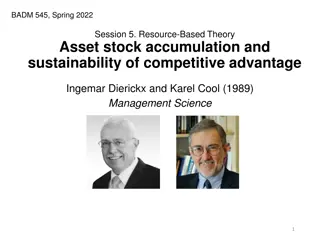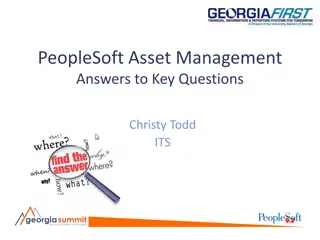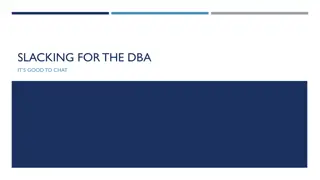
Investment Grade Bonds Overview 2022
"Explore the characteristics and performance of U.S. Investment Grade Bonds and Dynamic Bonds in 2022. Learn about historical returns, risk factors, correlations, pros and cons, and future forecasts for these bond categories. Find insights on potential returns, credit risk, interest rate exposure, and more. Stay informed with valuable information on these key asset classes for investment decisions."
Uploaded on | 2 Views
Download Presentation

Please find below an Image/Link to download the presentation.
The content on the website is provided AS IS for your information and personal use only. It may not be sold, licensed, or shared on other websites without obtaining consent from the author. If you encounter any issues during the download, it is possible that the publisher has removed the file from their server.
You are allowed to download the files provided on this website for personal or commercial use, subject to the condition that they are used lawfully. All files are the property of their respective owners.
The content on the website is provided AS IS for your information and personal use only. It may not be sold, licensed, or shared on other websites without obtaining consent from the author.
E N D
Presentation Transcript
U.S. Investment Grade Bonds Represented by the Barclays U.S. Aggregate Bond Index, the category represents investment grade bonds traded in United States. The index includes Treasury securities, Government agency bonds, Mortgage-backed bonds, Corporate bonds and a small amount of foreign bonds traded in the US. Municipal bonds and TIPS are excluded from the index. Historical Returns as of 06/30/22 Bloomberg US Agg Bond TR USD 10-Year Forecasts Annual Return Annual Risk 1 Year 3 Year 5 Year 10 Year 15 Year Annualized Total Returns -10.3% -0.9% 0.9% 1.5% 3.3% 3.4% 6.9% Annualized Standard Deviation 5.1% 4.6% 4.0% 3.5% 3.6% Highest Correlation: Municipal Bonds TIPS Foreign Bonds EM Bonds Pros: Cons: Modest Return Potential: Heavy exposure to U.S. Treasury & Agency issues moderates return potential. Relatively low exposure to corporate debt. Credit Risk: Subject to some relatively modest credit risk. Interest Rate Risk: Bond prices fall in a rising interest rate (and/or inflationary) environment. Intermediate Duration: Relatively modest average duration (typically between 4 - 6 years) leads to moderate volatility. High Quality: Heavy exposure to highest quality (AAA) U.S. fixed income market segments. No high yield (BB or lower) exposure. Deflation/Disinflation Protection: Declining (investment grade) interest rates lead to short-term price gains. Crisis Resistant: Capable of generating positive returns in times of economic and/or financial turmoil. Lowest Correlation: EM Equity Alternatives International Equity Global Equity Any forecast represent median expectations and actual returns, volatilities and correlations will differ from forecasts. Please see Fiducient Advisors most recent 10-Year Capital Market Forecasts white paper for additional information. Past performance does not indicate future performance.
Dynamic Bonds Bonds issued in the United States & foreign developed countries including but not limited to, Japan, United Kingdom, France, Germany, Italy, Spain, Canada, Netherlands, Belgium, Australia, Denmark, Sweden and emerging economies. Issues include government securities, corporate credit, structured securities and derivatives. Derivative allocations include futures, swaps and forwards, which may be utilized to hedge exposures or create synthetic exposures. Historical Returns as of 06/30/22 10-Year Forecasts *Custom Blend of Indices Annual Return Annual Risk 1 Year 3 Year 5 Year 10 Year 15 Year Annualized Total Returns -7.3% 0.0% 1.5% 2.5% 3.4% 3.4% 5.7% Annualized Standard Deviation 3.6% 4.2% 3.5% 2.9% 3.7% Highest Correlation: Cons: Credit risk: elevated allocations to investment grade and high yield corporate credit increases default risk and correlations to equity portfolios Overlap: portfolios are structured to be dynamic, tactical and flexible. Because of this, portfolios may result in concentrated single sector or market exposures depending on prevailing market conditions Foreign exchange: global in nature, these portfolios will oscillate between dollar denominated and non-dollar securities and currency positions. This may result in additional volatility depending on FX valuations Pros: Large Opportunity Set: Majority of the world's bond issues are outside the United States. Limited Interest Rate Exposure: strategies exhibit lower interest rate exposures through the utilization of cash or derivatives. Diversification Benefits: Historically, offered low correlation to other fixed income asset classes and global equities. Increased credit: shifts in central bank rate setting policy demand greater credit exposures in portfolios. HY Bonds U.S. Large Cap Broad Real Assets Lowest Correlation: U.S. Bonds International Equity Any forecast represent median expectations and actual returns, volatilities and correlations will differ from forecasts. Please see Fiducient Advisors most recent 10-Year Capital Market Forecasts white paper for additional information. Past performance does not indicate future performance.
High Yield Bonds High yield bonds are bonds that are rated below investment grade (BB or lower). These bonds have higher default or other credit event risk, but typically pay higher yields than higher rated bonds to attract investors. 10-Year Forecasts Historical Returns as of 06/30/22 Bloomberg US Corporate High Yield TR USD Annual Return Annual Risk 1 Year 3 Year 5 Year 10 Year 15 Year Annualized Total Returns -12.8% 0.2% 2.1% 4.5% 5.8% 5.5% 13.8% Annualized Standard Deviation 8.0% 10.1% 8.4% 7.0% 10.0% Highest Correlation: U.S. Mid Cap U.S. Small Cap U.S. All Cap Global Equity Real Estate Lowest Correlation: Cons: Volatility: More volatile than investment grade bonds. Spread Risk: Rising credit spreads adversely affects prices (and returns). Credit/Default Risk: Higher probability of defaults (with lower recovery rates) than investment grade bonds. Correlation to Equities: Higher correlation to equities (particularly in stress environments) than to other fixed income asset classes. Pros: High Current Income: Offer yield spreads above Treasuries and investment grade corporate bonds. Lower Duration: Typically, shorter maturities and lower interest rate sensitivity. Changes in credit spreads drive volatility (more than changes in interest rates). Diversification Benefits: Historically, offered relatively low correlation to investment grade fixed income and modest correlation to equities. Foreign Bonds Muni Bonds Commodities Any forecast represent median expectations and actual returns, volatilities and correlations will differ from forecasts. Please see Fiducient Advisors most recent 10-Year Capital Market Forecasts white paper for additional information. Past performance does not indicate future performance.
Global Bonds Bonds issued in the United States & foreign developed countries including but not limited to, Japan, United Kingdom, France, Germany, Italy, Spain, Canada, Netherlands, Belgium, Australia, Denmark, Sweden and emerging economies. Historical Returns as of 06/30/22 Bloomberg Global Aggregate TR Hdg USD 10-Year Forecasts Annual Return Annual Risk 1 Year 3 Year 5 Year 10 Year 15 Year Annualized Total Returns -8.9% -1.1% 1.2% 2.2% 3.4% 3.0% 7.3% Annualized Standard Deviation 4.0% 3.8% 3.4% 3.0% 3.0% Highest Correlation: Pros: Cons: Interest Rate Volatility: global bonds traditionally exhibit more interest rate exposure through longer duration bonds Volatility: Non-currency hedged bonds can be volatile given foreign currency fluctuations relative to the dollar. Risk: Subject to foreign financial, economic and geopolitical risk. Non-U.S. Interest Rate Exposure: Potential exposure to rising interest rates outside the U.S., resulting in price depreciation. Large Opportunity Set: Majority of the world's bond issues are outside the United States. Non-U.S. Interest Rate Exposure: Offers some potential insulation from rising U.S. interest rate environment. Diversification Benefits: Historically, offered low correlation to other fixed income asset classes and global equities. Foreign Currency Exposure: Unhedged currency can provide for protection against weakening U.S. dollar. Flexible Mandates: Managers can allocate risk more tactically across global sovereign, global credit and global currencies U.S. Bonds Dynamic Bonds Lowest Correlation: U.S. Small Cap EM Equity International Equity Any forecast represent median expectations and actual returns, volatilities and correlations will differ from forecasts. Please see Fiducient Advisors most recent 10-Year Capital Market Forecasts white paper for additional information. Past performance does not indicate future performance.
Large Cap U.S. Stocks Stocks with market capitalizations greater than $10 Billion. Large cap stocks represents the vast majority of the total U.S. equity market. Historical Returns as of 06/30/22 S&P 500 TR USD 10-Year Forecasts Annual Return Annual Risk 1 Year 3 Year 5 Year 10 Year 15 Year Annualized Total Returns -10.6% 10.6% 11.3% 13.0% 8.5% 6.5% 16.5% Annualized Standard Deviation 17.9% 18.6% 16.9% 13.7% 15.8% Highest Correlation: Pros: Cons: Risk: Subject to equity risk. Lower Risk Premium: Less risk, but potentially less long-term return than mid cap, small cap, or emerging market equities. U.S. All Cap U.S. Mid Cap Global Equity U.S. Small Cap Large and Liquid Market: U.S. large cap stocks represent the largest and most liquid segment of the global equity market. Long Historical Data Set: The S&P 500 Index performance history dates back to January 1, 1926. Less Volatility: Lower long-term volatility than mid cap, small cap, or foreign equity markets. Lowest Correlation: TIPS Foreign Bonds Municipal Bonds U.S. Bonds Commodities Any forecast represent median expectations and actual returns, volatilities and correlations will differ from forecasts. Please see Fiducient Advisors most recent 10-Year Capital Market Forecasts white paper for additional information. Past performance does not indicate future performance.
Mid Cap U.S. Stocks Stocks between $2 and $10 billion in market capitalization. 10-Year Forecasts Historical Returns as of 06/30/22 Russell Mid Cap TR USD Annual Return Annual Risk 1 Year 3 Year 5 Year 10 Year 15 Year Annualized Total Returns -17.3% 6.6% 8.0% 11.3% 7.8% 6.8% 18.2% Annualized Standard Deviation 17.6% 21.7% 19.3% 15.5% 18.3% Highest Correlation: Pros: Cons: Risk: Higher volatility than large cap stocks. Diversification: High correlation to both large cap and small cap stocks. Mid cap has a very high correlation to a 60/40 large & small cap mix. Arbitrary Classification: Arbitrary divide between "smaller" large cap and "larger" mid cap stocks. Conflicting definitions of mid-small cap barrier. U.S. All Cap U.S. Small Cap U.S. Large Cap Global Equity Risk Premium: Offers a potential risk-premium over large cap stocks. Higher Growth: Smaller companies can grow earnings faster than larger companies. Less Volatility: Lower long-term volatility than small cap stocks. Lowest Correlation: TIPS Foreign Bonds Municipal Bonds U.S. Bonds Commodities Any forecast represent median expectations and actual returns, volatilities and correlations will differ from forecasts. Please see Fiducient Advisors most recent 10-Year Capital Market Forecasts white paper for additional information. Past performance does not indicate future performance.
Small Cap U.S. Stocks Stocks with $2 billion (or less) in market capitalizations. 10-Year Forecasts Historical Returns as of 06/30/22 Russell 2000 TR USD Annual Return Annual Risk 1 Year 3 Year 5 Year 10 Year 15 Year Annualized Total Returns -25.2% 4.2% 5.2% 9.4% 6.3% 6.8% 21.1% Annualized Standard Deviation 17.0% 24.3% 22.0% 18.4% 20.7% Highest Correlation: U.S. All Cap U.S. Mid Cap U.S. Large Cap Global Equity Real Estate Lowest Correlation: TIPS Foreign Bonds Municipal Bonds U.S. Bonds Commodities Cons: Risk: Higher volatility than large cap and mid cap stocks. Liquidity/Opportunity Set: Smaller capitalization stocks have less liquidity and marketability. Access to quality small cap managers is often constrained. Pros: Risk Premium: Offers a potential risk-premium over large and mid cap stocks. Higher Growth: Smaller companies can grow earnings faster than larger companies. Upside: Virtually all large cap stocks started as small cap stocks at one time in their history. Any forecast represent median expectations and actual returns, volatilities and correlations will differ from forecasts. Please see Fiducient Advisors most recent 10-Year Capital Market Forecasts white paper for additional information. Past performance does not indicate future performance.
International Developed Equity Stocks of companies located outside of the U.S. in developed countries. Countries include Japan, the United Kingdom, France, Germany, Australia, Austria, Belgium, Denmark, Finland, Greece, Hong Kong, Ireland, Italy, the Netherlands, New Zealand, Norway, Portugal, Singapore, Spain, Sweden and Switzerland. Historical Returns as of 06/30/22 MSCI EAFE GR USD 10-Year Forecasts Annual Return Annual Risk 1 Year 3 Year 5 Year 10 Year 15 Year Annualized Total Returns -17.3% 1.5% 2.7% 5.9% 1.9% 9.3% 21.8% Annualized Standard Deviation 14.5% 18.0% 15.9% 13.9% 17.7% Highest Correlation: Pros: Cons: Equity Risk: Subject to global economic/financial conditions. Currency Risk: Subject to currency risk as investment returns are translated back into U.S. dollars. Political, Financial, Currency, and Regulatory Risks: Each country or region has its own political, financial, currency and regulatory risks. Global Equity EM Equity U.S. All Cap U.S. Large Cap Large Universe: Consists of publicly traded companies in developed countries domiciled outside of the U.S. Diversification: Higher correlation to U.S. markets in recent years, but still low enough to warrant diversification. Currency Diversification: Add diversification through foreign currency exposure (away from the U.S. dollar). Lowest Correlation: TIPS Foreign Bonds U.S. Bonds Commodities Any forecast represent median expectations and actual returns, volatilities and correlations will differ from forecasts. Please see Fiducient Advisors most recent 10-Year Capital Market Forecasts white paper for additional information. Past performance does not indicate future performance.
Emerging Markets Equity Stocks of companies located outside of the U.S. in developing countries. Emerging markets countries are nations with social or business activity in the process of rapid growth and industrialization. Emerging market countries in the index include China, Brazil, South Korea, Taiwan, South Africa, India, Russia, Mexico, Israel, Malaysia, Chile, Turkey, Thailand, Poland, Colombia, Czech Republic, Egypt, Philippines and Argentina. Historical Returns as of 06/30/22 10-Year Forecasts MSCI EM GR USD Annual Return Annual Risk 1 Year 3 Year 5 Year 10 Year 15 Year Annualized Total Returns -25.0% 0.9% 2.5% 3.4% 2.3% 10.6% 28.5% Annualized Standard Deviation 11.2% 18.2% 17.1% 15.7% 21.4% Highest Correlation: Pros: Cons: Volatility: Opportunity for high returns comes with increased risk. Sensitivity to Extremes: More sensitivity to global economic crisis. Correlations rise vs. other risky assets during periods of extreme stress. Political, Financial, Currency, and Regulatory Risks: Emerging countries have greater political, financial, currency and regulatory instability than developed markets. Global Equity EM Bonds U.S. Mid Cap International Equity Higher Return Potential: Emerging economies may exhibit higher GDP growth than developed markets. Diversification: Diversification benefits, particularly if measured over longer holding periods (decades). Currency: Add diversification through foreign currency exposure (away from the U.S. dollar). Lowest Correlation: Municipal Bonds U.S. Bonds Foreign Bonds TIPS Any forecast represent median expectations and actual returns, volatilities and correlations will differ from forecasts. Please see Fiducient Advisors most recent 10-Year Capital Market Forecasts white paper for additional information. Past performance does not indicate future performance.
Real Estate Investment Trusts Real Estate Investment Trusts (or REITs) is a tax designation for a companies investing in real estate that reduces or eliminates corporate income taxes. In return for the favorable tax treatment, REITs are required to distribute 90% of their (taxable) income to investors. REITs can be publicly or privately held. Public REITs may be listed on public stock exchanges like shares of common stock in other firms. Historical Returns as of 06/30/22 FTSE Nareit All Equity REITs TR USD 10-Year Forecasts Annual Return Annual Risk 1 Year 3 Year 5 Year 10 Year 15 Year Annualized Total Returns -5.9% 5.3% 6.7% 8.3% 6.4% 5.8% 18.5% Annualized Standard Deviation 21.3% 19.9% 17.6% 15.4% 22.8% Highest Correlation: U.S. Mid Cap U.S. Small Cap U.S. All Cap U.S. Large Cap High Yield Bonds Lowest Correlation: Foreign Bonds Municipal Bonds U.S. Bonds TIPS Commodities Pros: Cons: Volatility: Relatively high volatility. Heavy Reliance on Credit: REITs are unique in their heavy reliance on the credit markets, subjecting them to added risk in difficult credit environments. Fat Tails: Relatively high fixed cost businesses coupled with leverage make REITs vulnerable to extreme events (or fat left tails). Dividend Yield: While an equity asset class, dividend yields have historically exceeded other equity classes. Diversification Benefits: Have often offered relatively low correlation to both stocks and bonds. Any forecast represent median expectations and actual returns, volatilities and correlations will differ from forecasts. Please see Fiducient Advisors most recent 10-Year Capital Market Forecasts white paper for additional information. Past performance does not indicate future performance.
Broad Real Assets A real asset is a value-generating, physical/tangible asset that has intrinsic value in and of itself. Examples of real assets include land, metals, real estate, infrastructure and commodities. Diversified real asset portfolios strategically and tactically allocate among the various real asset categories, with the goal of providing investors with absolute return, a hedge against rising inflation, and low correlation to more traditional investments. Historical Returns as of 06/30/22 S&P Real Asset TR USD 10-Year Forecasts Annual Return Annual Risk 1 Year 3 Year 5 Year 10 Year 15 Year Annualized Total Returns -4.9% 3.5% 4.5% 4.4% 4.4% 5.4% 12.3% Annualized Standard Deviation 11.3% 14.3% 12.0% 9.9% 11.8% Cons: Short history: Diversified Real Assets are a relatively new asset class. While many of the underlying components themselves have longer track records, others, such as TIPS (late 1990 s) and MLPs (early 1990 s) remain limited. Exposure to super-cycles: The more tangible real asset categories (direct commodities, natural resources) have historically gone through super-cycles. This can result in lower returns for extended periods when inflation is subdued. This risk is mitigated through diversified portfolios exposure to equities, which should mitigate prolonged periods of muted returns. Unique Risk Exposures: Real assets may be more heavily exposed to geopolitical, weather-related, and regulatory risks. These risks can often be sudden and unavoidable. Heterogeneity: Due to the breadth of the investable universe with multiple underlying categories, real asset portfolios can look quite different from another. This can create challenges in benchmarking and in comparing portfolios. Pros: Hedge against rising inflation: Due to their inherent physical nature, real assets provide a hedge against rising levels of inflation, especially unexpected inflation. Additionally, many real asset securities have cash flows and revenue streams that are directly linked to CPI. Diversification: Real assets have low correlations with traditional asset classes, such as stocks and bonds. Alternative Income: Select areas, such as Real Estate and Infrastructure, often have an attractive income component that helps to mitigate volatility. Any forecast represent median expectations and actual returns, volatilities and correlations will differ from forecasts. Please see Fiducient Advisors most recent 10-Year Capital Market Forecasts white paper for additional information. Past performance does not indicate future performance.
Diversified Hedge Fund Portfolio A portfolio that allocates to a diversified pool of underlying hedge fund strategies and managers. Historical Returns as of 06/30/22 HFRI Fund of Funds Composite USD 10-Year Forecasts Annual Return Annual Risk 1 Year 3 Year 5 Year 10 Year 15 Year Annualized Total Returns Annualized Standard Deviation -4.4% 4.3% 3.9% 3.9% 1.9% 7.2% 8.7% 4.2% 7.2% 6.2% 4.9% 5.6% *HFRI Fund of Funds Index subject to periodic revisions. Highest Correlation: Pros: Cons: Transparency: Holdings, style, strategy and leverage may be constantly changing. By definition, hedge fund strategies are constantly evolving. Fees: High management fees and (trading) expenses. Funds of hedge funds have another layer of management fees. Leverage: Underlying hedge fund strategies often require leverage, increasing return potential and risk. Esoteric Risks: Illiquidity, fraud, regulatory, herd behavior, blind pool, extreme non-normal returns (or fat tails), fluid structure and terms, and others. EM Equity U.S. Mid Cap Global Equity U.S. Small Cap Capital Preservation: Ability to make money and/or limit losses in down markets. High (relative) historical risk- adjusted return. Diversification: Provides investors ability to generate a higher expected return for an aggregate portfolio while reducing overall equity allocation. Alignment of Interests: Managers invest alongside their clients and charge incentive fees. Lowest Correlation: Foreign Bonds Municipal Bonds U.S. Bonds TIPS Any forecast represent median expectations and actual returns, volatilities and correlations will differ from forecasts. Please see Fiducient Advisors most recent 10-Year Capital Market Forecasts white paper for additional information. Past performance does not indicate future performance.
Private Equity Private equity is a non-publicly traded asset class with a wide range of investment strategies and styles. Investment strategies typically follow the corporate lifecycle; Venture Capital (VC), Growth Equity, Levered Buyout and Distressed/Special Situations. Historical Returns as of 06/30/22 10-Year Forecasts Cambridge PE 67% Buyout vs. 33% Venture Annual Risk Annual Return 1 Year 3 Year 5 Year 10 Year 15 Year Annualized Total Returns Annualized Standard Deviation 0.0% 11.6% 13.4% 13.4% 10.6% 9.6% 23.0% 0.0% 7.3% 5.8% 4.4% 5.1% *Returns are typically lagged by 1-2 quarters. **Illiquidity makes performance volatility impossible to measure precisely. Pros: Cons: Illiquidity Risk: 10 plus year investment cycles. Illiquidity and J- Curve investment cycle makes it difficult to hold a targeted allocation percentage (and rebalance). Higher Performance Dispersion: High dispersion of returns between top and bottom performing managers compared to most other asset classes. Blind Pool Risk and Low Transparency: Inability to preview investments before committing capital and more difficult to monitor investments. Leverage: Some private equity strategies require substantial leverage adding risk. Fees: Very high management and incentive fees as well as administrative expenses. Esoteric Risks: Fraud, regulatory, disparate/complex structures and terms, and others. Inefficiency & Risk Premiums: Greater opportunity for active management to add value. Theoretically requires an illiquidity risk premium. Board Representation: Ability to proactively influence business strategy and operations. Excess Return Potential: Top managers have historically outperformed publicly traded equity indexes. Access to Smaller Companies: Ability to access a part of the market not available to public equity investors. Any forecast represent median expectations and actual returns, volatilities and correlations will differ from forecasts. Please see Fiducient Advisors most recent 10-Year Capital Market Forecasts white paper for additional information. Past performance does not indicate future performance.
Disclosures This document is intended for the exclusive use of clients or prospective clients of PCS Advisors. Any additional dissemination or distribution is strictly prohibited. Information provided in this document is for informational and/or educational purposes only and is not, in any way, to be considered investment advice nor a recommendation of any investment product or service. Advice may only be provided after entering into an engagement agreement and providing PCS Advisors with all requested background and account information. In partnership with Fiducient Advisors, the included information has been obtained from a variety of sources believed to be reliable though not independently verified. Any forecasts represent future expectations and actual returns, volatilities and correlations will differ from forecasts. Past performance does not indicate future performance and there is a possibility of a loss. Please visit www.pcsbd.net/disclosures for other important disclosures. Private Client Services is an SEC Registered Investment Advisor doing business as PCS Advisors. For information about Fiducient Advisors please visit www.fiducientadvisors.com. 24


